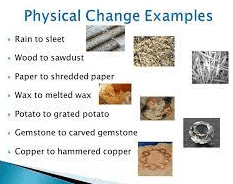What are Some Examples of Physical Changes?
 Physical changes are modifications or transformations that occur in any matter but do not imply a change in its nature or composition. The latter would imply a chemical change. Common Examples of Physical changes are the breaking of glass, mixing candies, melting ice, and folding Paper.
Physical changes are modifications or transformations that occur in any matter but do not imply a change in its nature or composition. The latter would imply a chemical change. Common Examples of Physical changes are the breaking of glass, mixing candies, melting ice, and folding Paper.
Physical changes occur in relation to volume, shape, or even state. That is why they can be detected from observation or by measuring the body in question.
A very simple way to recognize if any matter has undergone a physical change is that it can be reversed and return to its previous state.
Types of physical changes
Within the physical changes we can identify three large groups:
volume changes
- Dilation . This is the change that occurs when, after the body is in contact with certain high temperatures, its size increases. Dilation can affect substances that are in solid, liquid, and gaseous states.
- Contraction. In opposition to the previous change, in this one, the size of the element is reduced after coming into contact with low temperatures.
Regressive changes
Changes like these are what occur when bodies cool down. These three variants can be identified:
- Condensation. When speaking of this change, reference is made to the transformation of a body that is in a solid, to one in a liquid state.
- Solidification. As its name suggests, in this case, the body becomes a solid, when previously it was a liquid element.
- Regressive Sublimation. This change occurs when an element goes from being in a gaseous to a solid state.
Regressive changes
Changes like these are those that occur when bodies come into contact with high temperatures. These four variants can be identified, which are detailed below:
- Evaporation. In this case, the substance passes from the liquid to the gaseous state as a consequence of the high temperatures. This phenomenon can also occur at room temperature.
- boiling. While in the previous case only the surface particles are affected, in this case, it reaches all of them. And it also has to do with going from a liquid to a solid state.
- Fusion. This change is observed when a substance changes from a solid to a liquid state after being heated at high temperatures.
- Progressive sublimation. In this case, after the substance comes into contact with high temperatures, it changes from a solid to a gaseous state.
Read Also: Examples of Liquids to Solids Conversion
Physical change Examples
Below is a list of examples of these kinds of changes:
- When an ice cube is placed near the fire and it melts, it goes from solid to liquid, but without losing its nature.
- When a sheet of paper is torn into several pieces.
- When the mercury found in a thermometer comes into contact with high temperatures, its size expands, but its nature does not change for this.
- When water is boiled in a pot, it changes from a solid to a gaseous state.
- When a glass fogs up, after a while they begin to make droplets. This is a consequence that the water vapor is transformed into liquid.
- When the ice cream is out of the freezer and thaws.
- When glass comes into contact with elevated temperatures, it becomes more malleable.
- When a piece of cheese is grated with a grater.
- When the clouds collide and it rains, the water changes from a gaseous state to a liquid.
- When a metal such as gold is melted, it changes from a solid to a liquid state.
- Dissolve a tablespoon of sugar in a glass of water. Although the former dissolves, neither of the two elements can its qualities.
- When we forget a bottle of coke in the freezer and it freezes, it changes from a liquid to a solid state.
- When there are high temperatures and the cement of the street swells and sometimes even breaks.
- When a piece of iron is filed.
- When we leave a bottle of alcohol open and it evaporates.
- When we fill the coolers with water and put them in the freezer, soon we will have ice cubes. In this case, the water passes from the liquid to the solid state.
- When we wash our hair and then dry it with the hair dryer.
- When we break a stone into several pieces.
- When we mold a piece of plasticine.
- Over time, perfumes evaporate. That is, they change from a liquid to a gaseous state.
